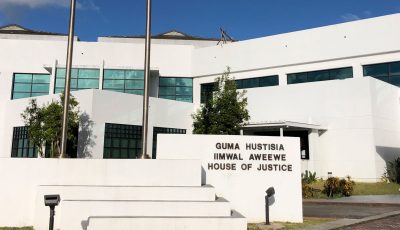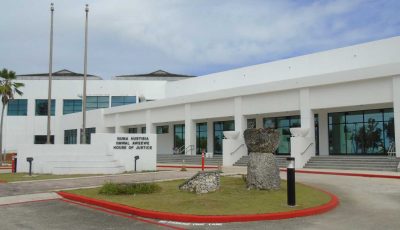‘1994 $15M loan to build Guma Hustisia fully paid in 2022’
The CNMI government’s $15-million loan from the NMI Retirement Fund in 1994 to build the Guma’ Hustisia in Susupe was paid in full in March 2022, according to CNMI Supreme Court Associate Justice John A. Manglona.
Speaking at the House Ways and Means Committee hearing for the proposed 2024 budget for the Judiciary, Manglona said the Retirement Fund loan has already been fully paid—as mentioned in their budget proposal and in their annual report.
Manglona said the fines and fees that were originally intended to pay off the loan now go directly to the Department of Finance’s account.
“It doesn’t rest with the court. So we are just a conduit, but I hope that they’re still untouched because there’s a specific law that says it’s for the Judiciary,” Manglona said.
Rep. Blas Jonathan T. Attao (Ind-Saipan) said it is their understanding that, upon the completion of that Retirement Fund loan payment, the Judiciary will be able to access those monies and portions of it will be distributed to the Department of Public Safety.
Manglona said the current statute does not have any language about DPS or Department of Corrections, and that it’s just referred to as the Judiciary Building Fund.
Manglona said he believes they now have to shift the focus to the treatment courts facility as their current facilities and offices and treatment center cannot work in the Guma’ Hustisia.
“So we are looking in that direction and use the fines and fees to focus on the treatment court center,” said Manglona, adding that the center will house the mental health court, drug court, veterans court, and possibly the probation office.
In response to questions by Rep. Manny Gregory Castro (Ind-Saipan), director of Courts Sonia A. Camacho said fees collected from traffic citations go to an account held by the Finance secretary and that in the original bill for the Judicial Building Fund, it went to pay the loan for the court house. Since that loan has already been paid, Camacho said there is a special setup called the Justice Fund, that’s where those funds go.
She said there is an existing statute that says a portion of the funds will be for the rehabilitation of the Guma’ Hustisia.
“There’s additional clause in the existing statute that explains [that] after the loan is paid off, a percentage of that is set aside for the continuing rehabilitation of the building,” she said.
Not that he wants to take money away from the court, Castro said, but the fact that the loan has already been paid off, there are also other government facilities that may need rehabilitation.
“I believe that the Department of Public Safety should also get a portion of those citations so that they can improve their facilities,” Castro said.
He underscored the need to also beef up DPS’ forensics capacity.
“Don’t worry we’re not [going to] touch that fund… but maybe we need to give a little bit to other agencies so that they can help you guys do what you do best,” Castro said.
The government was allowed to secure a $15 million loan from the NMI Retirement Fund through a Judicial Building Financing Act of 1994 in order to build the Guma’ Hustisia in Susupe. Construction began in 1995 and was completed in May 1998. The revenues generated by the Judiciary were the primary sources of repayment of the loan.
When the loan matured in March 2015, it was not fully paid. The Settlement Fund subsequently extended the repayment terms of the loan.
In September 2019, NMI Settlement Fund trustee Joyce C. H. Tang informed the federal court that the government has been exploring the possibility of obtaining a $12-million loan with the USDA to pay off the building loan and pay for other needed courthouse renovations.
Tang said the original plan was that $4.8 million of the $12-million loan would go to the Settlement Fund as lump sum payment for the Judicial Building loan.
The remaining amount will go into construction and renovation of judicial facilities in the CNMI, the Office of the Attorney General, and the Public Defender’s Office.



























